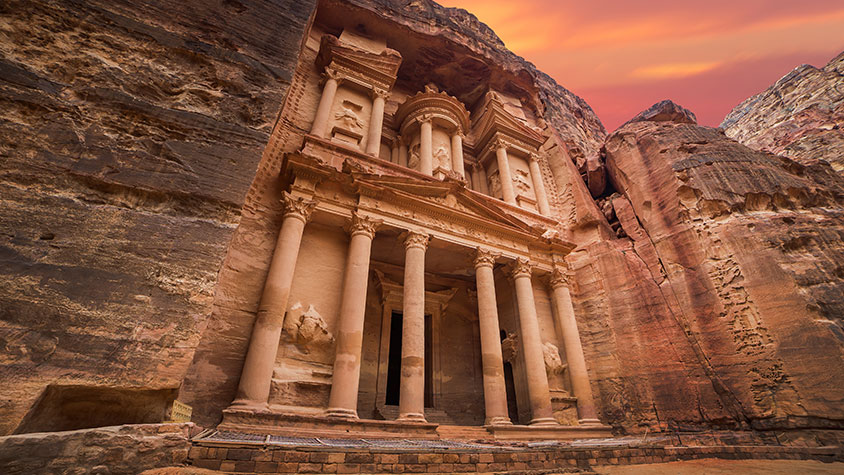Half hidden in the windblown landscape of southern Jordan, the ancient sandstone city of Petra has been named one of the New Seven Wonders of the World, as well as being a UNESCO World Heritage site.
Petra was built in the third century BC by the Nabataeans, a community of master builders who, besides being geniuses at hydraulic engineering, also carved magnificent structures from the surrounding sandstone cliffs.
Petra is approached through the 0.75 mile-long, high-walled Siq—a crack in the rock that was torn apart by tectonic forces, creating a canyon-like passage with narrow vertical walls. The wide path below the towering cliffs snakes its way toward the hidden city, revealing one of the most impressive of Petra’s sights: the Treasury.
Carved out to serve as a tomb, the Treasury gets its name from the local belief that an Egyptian pharaoh stowed away his worldly treasure in the top urn to avoid pilfering of his tomb. In fact, many have tried over the centuries.
An earthquake in AD 555 is the most likely cause of the city's demise. Thankfully, many of Petra's most impressive structures remain intact, making it an architectural marvel—marvelous enough for the blockbuster movie, Indiana Jones and the Last Crusade to be partially filmed there.
Who can forget Indy (Harrison Ford) and his dad (Sean Connery) walking deep into the labyrinths of the Treasury to seek out the Holy Grail? Other notable structures in Petra are the weather-worn 7,000-seat theatre, alongside which is a long set of steps that ascend to the High Place of Sacrifice. Those visitors who are hale and hearty will be challenged by the steep, 45-minute climb back in time to this place where animals were sacrificed to appease ancient gods.
While the “Holy Grail” may have fallen into the chasm of The Treasury grasped tightly by a woman greedy for its perceived power (Elsa in the Last Crusade), there is no doubt that the impressive structures of Petra are the Holy Grail of ancient sandstone architecture anywhere. But aside from the beauty and intrigue of Petra, there is some biblical significance to this ancient pagan city.
Moses and the Israelites passed through the Petra area in Edom. According to local tradition, Moses also struck the rock and brought forth water at Wadi Musa (Valley of Moses), just outside Petra.
Christianity found its way to Petra (called Sela in Hebrew) in the 4th century AD, nearly 500 years after the establishment of Petra as a trade center. Constantine the Great, the first Christian Emperor of Rome helped Christianity spread throughout the Roman Empire—including Petra—until the Islamic conquest of 629–632.
Today, visitors to Petra are welcomed both by the Bedouin—who still relate to the Ancient City as home—and the townspeople of neighboring Wadi Musa whose facilities make a several-day visit to the Ancient City not just awe-inspiring, but fun!
Besides hiking and camping, there is also every traveler’s favorite pastime: people-watching. Viewing the colorful residents managing their camels and goats, along with the merchants’ daily interactions with tourists as enthusiastic vendors sell their wares, is always entertaining.
Holy Land travelers looking for distinct and memorable experiences can easily add Petra to the list. Besides having been the land of the Edomites—Israel’s enemy—it is a good place to ponder the faith and fortitude of Moses who called on the power of God and literally got water from a rock—a hard act to follow in any part of the world.
###
Experience Petra’s dramatic sandstone structures and the place where Moses is believed to have drawn water from a rock.
Email Cindy at cindy@israeladvantagetours.com or
visit www.israeladvantagetours.com to make your trip of a lifetime a reality!















